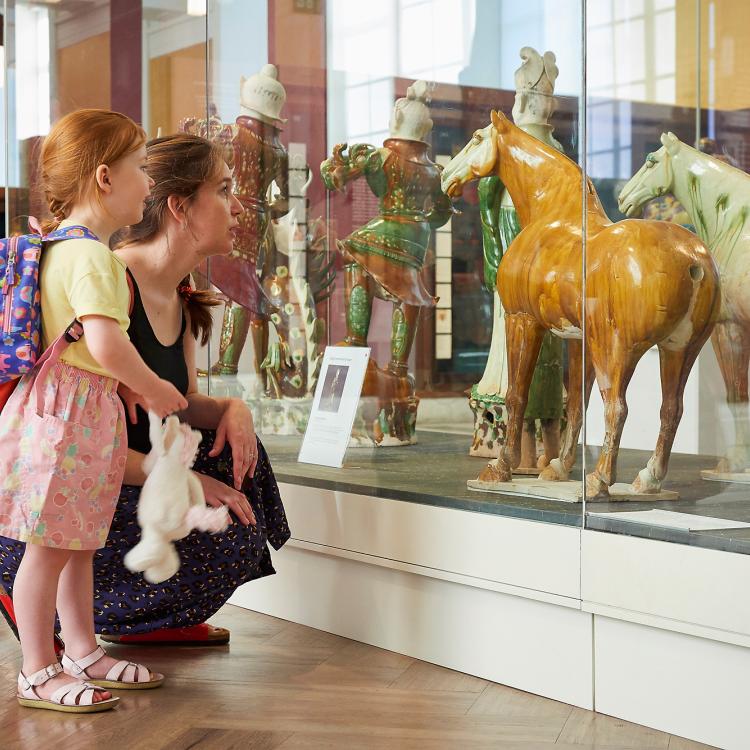Other object trails
Travel back in time on this twelve-object trail.
From ancient armour to mummified mammals and from bygone board games to massive monuments, these objects will captivate and inspire young minds.
Please note only certain galleries will be open to visitors.
Lower and ground floors
1. The Rosetta Stone (replica within Room 1)
The key that unlocked the hieroglyphic language of ancient Egypt, the Rosetta Stone is the Museum's most popular exhibit and one of the cornerstones of modern Egyptology. Don't leave without seeing it for yourself.
2. Bust of Ramesses the Great (Room 4)
2. Bust of Ramesses the Great (Room 4)
This impressive upper half of a colossal larger statue weighs 7.5 tonnes. It once sat in a temple in Egypt known as the Ramesseum. Ramesses II was one of the greatest Egyptian pharoahs.
Hoa Hakananai'a (Room 24)
3. Hoa Hakananai'a (Room 24)
This statue, known as Hoa Hakananai'a, comes from Rapa Nui (Easter Island). It has carvings on the back associated with the islanders' birdman cult. It is of great significance to the people of Rapa Nui today.
The Ife head (Room 25)
4. The Ife head (Room 25)
This spectacular brass sculpture, cast around 600 years old, is thought to depict the Ooni, a sacred king within the West African Kingdom of Ife. Between 1100 and 1400 Ife was one of the great city states in West Africa and a flourishing commercial centre.
Aztec serpent (Room 27)
5. Aztec serpent (Room 27)
Created in what is now Mexico in the 15th or 16th century, this extraordinary double-headed serpent sculpture is mostly made of turquoise pieces over a wooden base, and probably had ritual significance.
The Sloane Astrolabe (Room 1)
6. The Sloane Astrolabe (Room 1)
An astrolabe is an astronomical instrument that can be used to tell the time. Crafted about 1300, this astrolabe is named after Hans Sloane, whose collection formed the basis for the British Museum in 1753. It's the earliest and largest English astrolabe to have survived from the Middle Ages and shows a knowledge of Arabic astronomy and instrumentation.
Upper floors
7. Mummy of Katebet (Room 63)
One of the most-studied mummies in the Museum, Katebet was a Chantress of Amun, and would have sung and performed music during rituals. Both the mummy and the objects buried with her are incredibly well preserved, despite dating back to 1300 BC.
Mummified Bull
8. Mummified Bull (Room 62)
The Egyptians didn't just mummify people – they also preserved and wrapped their animals in a similar manner. This mummified bull was found in Thebes and is believed to have been preserved about 30 BC–AD 600.
9. Samurai armour (Room 92–94)
10. Samurai armour (Room 93)
Armour and weaponry defined the samurai's authority on the battlefield. This complete, matching set of armour was produced for a member of the powerful Mori family, who were samurai lords based in western Japan.
Royal Game of Ur (Room 56)
8. Royal Game of Ur (Room 56)
Originally played in the early third millennium BC and once popular across the Middle East, the rules of this two-player strategy board game were lost to history until British Museum curator Irving Finkel decoded a cuneiform tablet containing the instructions in the early 1980s.
11. Pieces of Eight (Room 68)
11. Pieces of eight (Room 68)
Evoke stories of pirates and buried treasure with these genuine pieces of eight, which formed the first global currency and were accepted as legal tender across Europe and the New World.
The Sutton Hoo ship burial (Room 41)
12. The Sutton Hoo ship burial (Room 41)
Found undisturbed in 1939, the many artefacts of the Sutton Hoo burial date back to 7th century Britain and are popularly believed to have belonged to Rædwald, an Anglo-Saxon king. See one of the most magnificent archaeological discoveries ever made in the UK for yourself.





